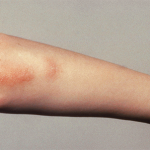The primary end point, the proportion of patients with GCA in sustained remission until week 28, was met. Dr. Thiel said, “Patients treated with secukinumab were 9.3 times more likely to stay in remission compared with patients treated with placebo [median odds ratio 9.3 with 95% credibility interval 3.5–26.3]. The Kaplan-Meier plot of time to first GCA flare after baseline up to week 52 was also quite impressive.”
Further, after the 26-week fixed regimen prednisolone taper, patients treated with secukinumab required less cumulative co-administered prednisolone than patients who received placebo. “Of note, glucocorticoid use in the placebo arm [may] be underestimated when compared with the use in the secukinumab arm because patients who discontinued the study were not taken into account, and more placebo patients discontinued before week 52,” Dr. Thiel said.
The safety profile of secukinumab was consistent with previously reported data, with no unexpected safety signals identified.
“I am very happy to let you know that a phase 3 study just started and recruited its first patients in the U.S., and I’m very honored to be the primary investigator on this study,” Dr. Thiel concluded.
Emapalumab in sJIA/MAS
Fabrizio de Benedetti, MD, PhD, head, Division of Rheumatology, head, Laboratory of ImmunoRheumatology, Ospedale Pediatrico Bambino Gesù, Rome, shared encouraging data on the use of emapalumab, an anti-interferon-gamma (IFNγ) monoclonal antibody, in the treatment of patients with systemic juvenile idiopathic arthritis and macrophage activation syndrome (sJIA/MAS) for whom high-dose glucocorticoids proved ineffective.8
Overproduction of IFNγ is present and pathogenic in several different animal models of hemophagocytic lymphohistiocytosis (HLH) and MAS. Neutralization of IFNγ has been shown to be efficacious in primary HLH and is FDA approved as a treatment.9
De Benedetti et al. studied 14 patients with sJIA/MAS for whom high-dose intravenous glucocorticoids administered for three or more days proved ineffective. Other therapies (e.g., cyclosporine A, anakinra) also proved ineffective for most patients.
Treatment with intravenous emapalumab resulted in rapid IFNγ neutralization and was rapidly efficacious in controlling MAS, with MAS remission achieved after a median time of 25 days. MAS remission was defined as a resolution of clinical signs and symptoms and normalization of laboratory parameters relevant to MAS. Emapalumab also allowed rapid and permanent tapering of glucocorticoids.
Nine adverse events related to emapalumab were reported, most of which were infectious. One patient experienced cytomegalovirus reactivation that resolved with antiviral treatment. All patients were alive at the last visit, and no patient discontinued emapalumab for safety reasons.

